

No matter where your travels take you, from national parks to backwoods to back porches, a camping sleeping bag is a trusty companion. Since space and weight are not at a premium when you can drive to your destination, the comfort dial can get turned way up. There’s no need to suffer through the night in a constricting mummy bag, so options in this category tend to lean more towards a traditional rectangular shape or a roomier mummy. We've been testing camping sleeping bags for over nine years now, and below we rank our top 15 picks for 2025. For more background information, see our comparison table and buying advice below the picks, along with details about our testing process.
Editor's note: We updated this guide on July 17, 2025, to reinstate the REI Siesta Hooded as our favorite sleeping bag now that it's available for purchase again. We also added the Alps OutdoorZ Redwood -10 as our choice for cold weather and the Teton Gear Polara as another 3-in-1 option, and moved the Kelty Cosmic Down 20 up in our rankings as a great budget option for down fill. Lastly, we added links to new in-depth reviews that we've written, removed the discontinued REI Frostbreak 5, and swept the article to make sure all other information was accurate at the time of publishing.
Shape: Rectangular
Temperature rating: 20°F
Fill: Synthetic
Weight: 5 lb. 7.3 oz. (medium)
What we like: Roomy and comfortable design; simple but thoughtful feature set
What we don’t: On the heavy and bulky side; rectangle shape is not as warm as a mummy design.
Mummy bags are popular for both camping and backpacking, but rectangular bags are roomier and can offer an even better sleeping experience. Our top pick in this category is REI Co-op’s Siesta Hooded 20, which was gone for a while but is happily available once again. For a reasonable $149, you get a high-quality bag with a useful 20-degree temperature rating, great for three-season car camping in a variety of conditions. Unlike many other rectangular bags, the Siesta also comes with a hood to boost warmth and secure your camping pillow, and an interior stash pocket helps stow items like a cell phone or headlamp that you might want to keep close during the night. We also love the handy two-way zipper that allows you to open the bag fully like a quilt or just unzip the bottom to let your feet out for some air. Additionally, there's a partial zipper on the other side that facilitates folding the top down like a blanket in your bed at home. Added up, the Siesta is comfy, well-appointed, and a fantastic value. It's also available in a Double version for couples or families.
Keep in mind that a rectangular bag is heavier than a mummy and doesn’t pack away nearly as small, so the Siesta isn’t intended for traveling far from your car or stuffing down into a backpack. To be fair, the 5-pound-7.3-ounce build (size medium) isn't overly excessive by any means, but it's heavier than quite a few competitors here. On the flip side, many will appreciate the thoughtful warmth-trapping extras, including a draft collar and tube to seal out cold around the neck and drawstring cinches to snug things down. Again, the Siesta isn't the lightest or most compressible, but it checks all the boxes we look for in a quality camping sleeping bag at an affordable price point. For an even cheaper option from REI, their Trailmade 20 costs just $100 and is viable for short backpacking trips with its tighter mummy shape and smaller packed size, at the sacrifice of some comfort.
Read more: REI Co-op Siesta Hooded 20 review
See the REI Co-op Siesta Hooded 20 See the REI Co-op Siesta Hooded 20 Double

 Shape: Rectangular (double)
Shape: Rectangular (double)
Temperature rating: 30°F
Fill: Synthetic
Weight: 8 lb. 14.7 oz. (one size)
What we like: A super comfortable and fully featured option for two campers; integrated sheet provides versatile and can be removed for washing.
What we don’t: Expensive, heavy, and bulky to stuff down; can't be separated into two single bags.
Car camping can be all about luxury, and for two people who don’t mind getting cozy, a double sleeping bag makes a whole lot of sense. Our favorite here is Nemo's Jazz 30 Double, which combines premium fabrics with generous dimensions and a functional feature set for two. The built-in bedsheet is one highlight: It’s exceptionally soft and comfortable, easy to remove with snaps at the sides, and machine-washable. In addition, the massive pillow pocket can fit two standard-sized pillows, the opening is wide with smooth-operating zippers, the integrated pad sleeve keeps things in place during the night, and the Blanket Fold draft collar effectively traps warmth. Finally, unlike many sleeping bags we’ve tested, the Jazz’s 30-degree rating actually feels pretty conservative—couples that run warmer may be able to push the limit into some lower temps, especially thanks to the largest hood.
What are the shortcomings of the Nemo Jazz 30 Double? The most glaring is the steep $350 price tag, although the luxurious build does come with a lot of tangible benefits (especially when paired with a high-end camping mat like Nemo's Roamer Double). Like most two-person bags, the Jazz is bulky and heavy at nearly 9 pounds, which is more than double many single rectangular bags. And unfortunately, you can’t separate the Jazz into two single bags like you can with Exped’s MegaSleep Duo below, although the top can be zipped fully down for airing out quickly on balmy nights. Another popular alternative to consider is Kelty’s Tru.Comfort Doublewide 20, which offers a modest step up in warmth for a considerable $135 less, but it's heavier, narrower, and less refined than the Jazz. In the end, it’s hard to beat the Nemo’s combination of comfort, build quality, and overall performance.
See the Nemo Jazz 30 Double
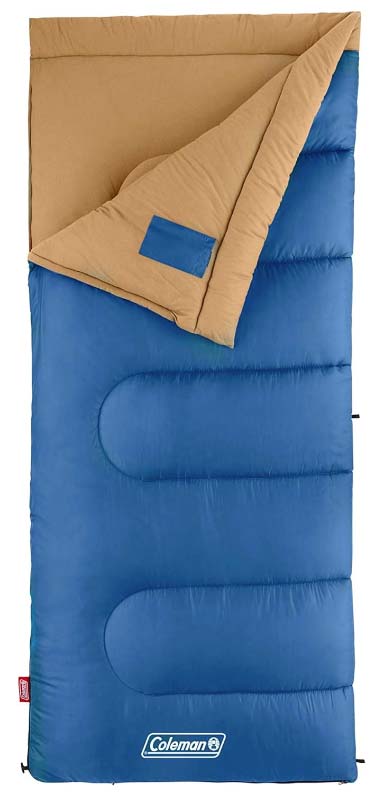 Shape: Rectangular
Shape: Rectangular
Temperature rating: 20°F (30°F available)
Fill: Synthetic
Weight: 6 lb. 15.2 oz. (one size)
What we like: A great price for a relatively warm and comfortable bag; two bags can zip together to create a double.
What we don’t: Hefty, bulky, and materials are on the cheaper end.
At the budget end of the spectrum, Coleman makes a nice lineup of basic 3-season sleeping bags for camping. Our current favorite is their Brazos 20, which checks most of the boxes for casual campers at a very palatable price point. Comfort-wise, it’s relatively cozy with a soft, flannel-like tricot lining and draft tube along the zipper to seal in warmth. You also get a thick outer shell that can stand up well to long-term use. As long as you set reasonable expectations, the Brazos will get the job done on cool to moderate summer and shoulder-season nights. For warmer conditions, you can snag the Brazos 30 for even less.
Cost and quality usually go hand in hand, and the Coleman Brazos’ build quality and materials are a step down from many of the other picks on our list. In terms of insulation, the bag is rated to keep you warm in 20- to 40-degree temperatures, but you’ll probably need some long underwear (and maybe an extra liner) at the lower end of that range. The Brazos is also noticeably hefty and bulky at just under 7 pounds and takes a good deal of effort to compress back into its stuff sack. The zipper has also been plagued by reports of stickiness and catching on the fabric, though we haven't personally had this issue. But mostly we keep coming back to value: The Brazos outperforms its price tag and offers everything most recreational campers need (and nothing they don’t). If you're able to take a step up in price, the Coleman Arch Bay is $80 and almost half the weight of the Brazos with more refined features.
Read more: Coleman Brazos 20 review
See the Coleman Brazos 20 See the Coleman Brazos 30
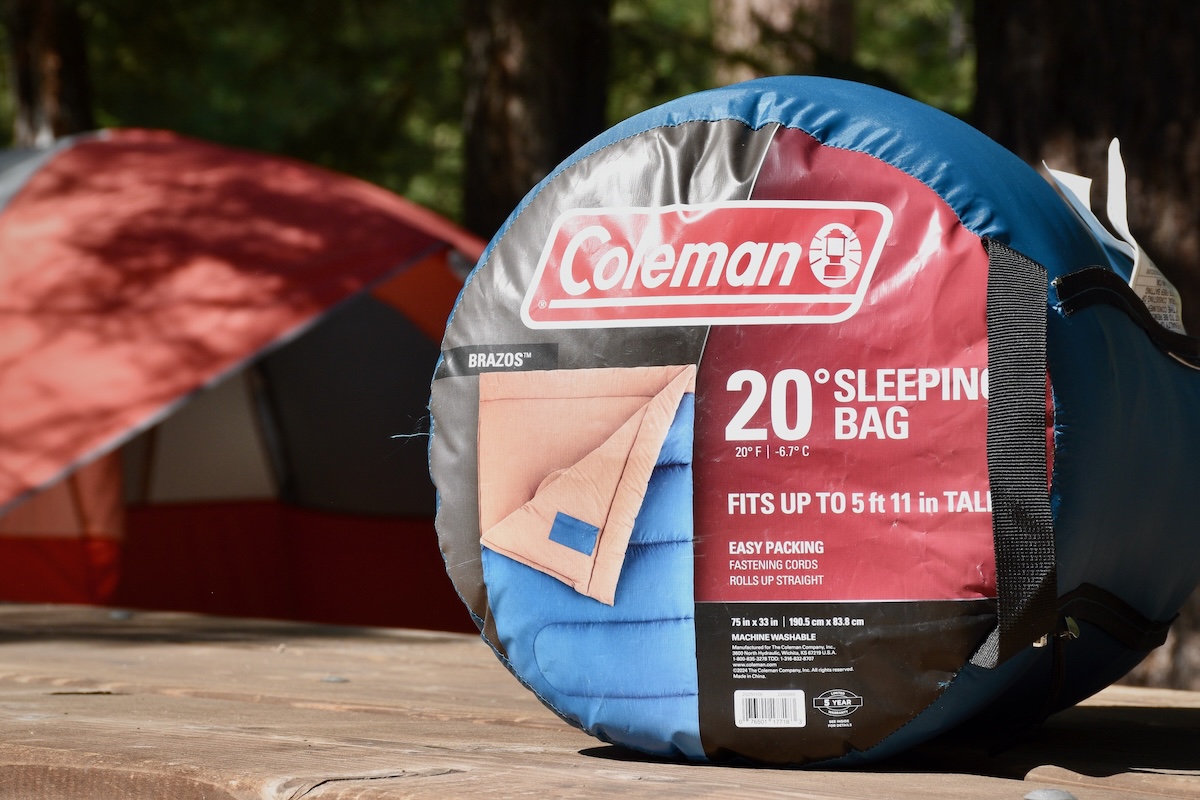
 Shape: Mummy
Shape: Mummy
Temperature rating: 20°F (0°F and 40°F available)
Fill: 550-fill down
Weight: 2 lb. 7 oz. (men's regular), 3 lb. 5 oz. (women's regular)
What we like: Great crossover bag; down insulation at a value price.
What we don’t: Too snug for comfort seekers; no longer uses hydrophobic down; women's version is more expensive (though it also has more fill).
Kelty’s popular Cosmic Down 20 has been a mainstay in their lineup for years and remains a popular choice among campers and backpackers alike. For starters, you get a respectable weight of 2 pounds 7 ounces (the women's version is quite a bit heavier at 3 lb. 5 oz., though it also has a full 15 oz. more down fill), making this the lightest 3-season option on our list (Kelty’s own Galactic 30 below weighs around the same but is far less versatile). Along with a healthy dose of 550-fill down, the bag offers cozy warmth and good compressibility. And considering the typical price of a down bag, the Cosmic Down's $180 MSRP really stands out. It’s worth noting that the women's-specific version is $10 more at $190, but, as noted, the extra cash gets you a lot more insulation: 29.6 ounces of down compared to just 14.6 ounces in the men’s version. If you run cold, this is a great option for the price, regardless of gender.
The latest version of the Cosmic Down 20 features some key changes over the previous model, including a recycled shell with a PFAS-free DWR coating and a 6-inch-wider footbox. The weight came down slightly as well, making the Cosmic a truly stellar deal for a down bag. Other features include a zippered internal stash pocket for essentials you want to keep nearby and two-way zippers for easy venting on balmy nights. The Cosmic collection also includes synthetic versions of the bag that cost less but are heavier and less compressible, along with newer Ultra models that swap in more premium 800-fill down to reduce weight and packed size. Lastly, if you need something more suited to colder temps, the Cosmic Down comes in a 0-degree version, as well as a 40-degree version for summer campers.
See the Men's Kelty Cosmic Down 20 See the Women's Kelty Cosmic Down 20
 Shape: Semi-rectangular
Shape: Semi-rectangular
Temperature rating: 16°F (men's ISO limit), 17°F (women's ISO limit)
Fill: 650-fill down
Weight: 2 lb. 11 oz. (men's regular), 3 lb. 5 oz. (women's regular)
What we like: Nice mix of comfort, weight, and packability with lots of premium features.
What we don’t: Expensive and a bit of a tweener: overkill for camping and a little heavy for backpacking.
For campers looking for a sleeping bag that can pull double duty on the occasional backpacking trip, we like Nemo’s Disco. With a 16-degree temperature rating (17-degree for the women's version), sub-3-pound weight (for the men's, the women's is heavier at 3 lb. 5oz. due to 9 oz. more fill), and decently packable build (it even includes a compression stuff sack), the Disco is fully serviceable for short forays into the backcountry. Just as importantly, it’s supremely comfortable for camping thanks to its unique “spoon” shape, which resembles a mummy bag but with a noticeable boost in space around the knees and elbows. This makes it less restrictive inside, particularly for side sleepers and those prone to tossing and turning. Additionally, the Disco is part of the brand’s Endless Promise collection, meaning it can be repaired, resold, or recycled at the end of its life to reduce waste (you can read more about Nemo’s process here). You pay a steep premium at $300 ($330 for the long version), but the top-end build quality and versatility help justify the cost—after all, there's no need to purchase (or store) a separate bag for backpacking.
In addition to its spoon shape, Nemo included a number of creative features on the Disco. One of our favorites is the two zippered “gills” along the top of the bag that can be opened on warm nights to keep you from overheating. Further, there’s a small blanket built into the collar that can be folded out or tucked in and around your neck depending on nighttime temperatures. It’s true that the Disco isn’t a perfect all-in-one answer—it’s overkill for car camping in hot weather (there is a Disco Endless Promise 30 available), and dedicated backpackers may want something even lighter and more compressible—but we love the balanced and adaptable design. For a cheaper option from Nemo that shares similar features but is lacking in backcountry appeal, check out their Forte Endless Promise 20 below.
See the Men's Disco Endless Promise 15 See the Women's Disco Endless Promise 15
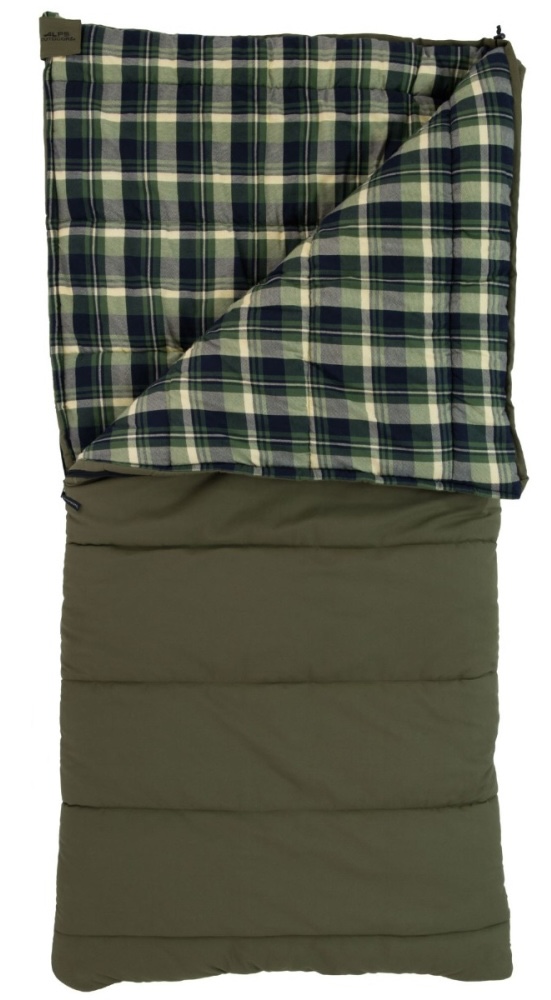 Shape: Rectangular
Shape: Rectangular
Temperature rating: -25°F (-10°F available)
Fill: Synthetic
Weight: 11 lb. 8 oz. (one size)
What we like: Plush, cozy, and very warm; fun vintage vibe; highly durable.
What we don’t: Extremely heavy and very large.
If you're looking for a bag you can use in the summer, keep reading, the Alps OutdoorZ Redwood isn't for you. But if you prefer to camp outside of the warmest months of the year and want something super warm and burly, look no further; the Redwood -25 gives us 1980s cabin vibes in the best way possible. With a durable and rugged canvas outer and a soft fleece interior, this is the kind of camping accessory you can buy once and have for life. There's no "swishy" nylon sound, and if you prefer to sleep with your four-legged friends, the Redwood can more than handle it. The weight and bulk of this bag can make sleeping in nature when it's super cold feel as cozy as it does at home—just don't get any ideas about carrying this thing too far from your vehicle. At 11 and a half pounds, this is the heaviest option in our lineup by a large margin.
While the Redwood is a stellar option for car campers and rustic cabin dwellers, it's not nearly as versatile as other contenders due to its weight and enormous packed size. It's also really warm—we didn't experience temps anywhere near -25 degrees during our testing period, but this bag was notably warmer than any other we've tested thus far. If you plan to have some summer campouts, you will absolutely need another sleeping bag in your arsenal. The Redwood is also available in a -10-degree version, but that will still be overkill for the warmest months of the year. If you're looking for something more streamlined, the Nemo Disco above is also very warm, much more streamlined, and less than a quarter of the weight of the Redwood. Additionally, the Teton Celsius 0 below is a solid budget option for colder temps. But if you crave your weighted blanket when you're camping at high altitude outside of summer, the Redwood is not to be missed.
See the Alps OutdoorZ Redwood -25
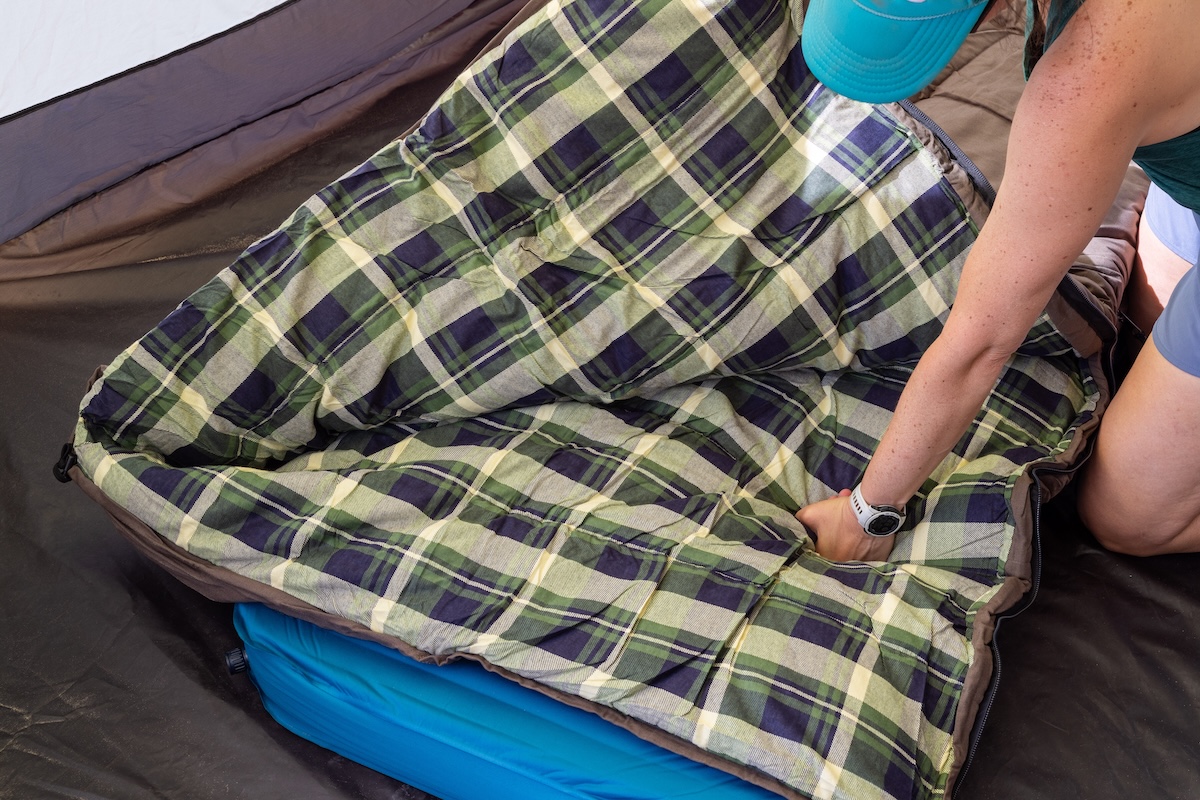
 Shape: Rectangular
Shape: Rectangular
Temperature rating: 20°F (35°F available)
Fill: Synthetic
Weight: 4 lb. 14.3 oz. (regular)
What we like: A viable competitor to the Siesta above in comfort and warmth.
What we don’t: Less packable and doesn't include a hood.
Like REI’s Siesta 20 above, The North Face’s Wawona Bed 20 is a well-rounded rectangular bag that nicely balances warmth, comfort, and cost. For $19 less than the Siesta, the Wawona Bed boasts a three-season-friendly temperature rating of 20 degrees, which will keep you comfortable down to around freezing if you factor in our recommended 10-degree buffer (just make sure to wear a beanie). The bag also has an impressively soft interior with a fleece-like lining towards the top and includes nifty details like a full-length zipper to open the bag up for use as a blanket (bonus: You can zip two Wawona Beds together to form a double bag). All together, this is an affordable but well-built design that will keep you cozy on most shoulder-season and summertime trips.
Despite costing a little less than the REI Siesta 20, The North Face Wawona Bed 20 falls slightly short in a few areas. The REI includes a hood, which ups both coziness and warmth, and it also packs down a little smaller (although the Wawona is lighter by 9 oz.). And while we consider the Wawona's price to be very fair, budget-minded campers and those who only get out a couple times a season can save with an option like Coleman’s Brazos 20 above or the Teton Gear Celsius 0 below. But both of those bags are a notable step down in quality from the Wawona Bed, and we think most campers will find the added investment worth it. The North Face also sells the Wawona in a 35-degree version for warmer adventures, as well as a two-person version for couples and families. The Wawona Double is a more wallet-friendly alternative to the Nemo Jazz above for those willing to compromise a little on features and overall comfort.
Read more: The North Face Wawona Bed 20 review
See The North Face Wawona Bed 20 See The North Face Wawona Bed Double
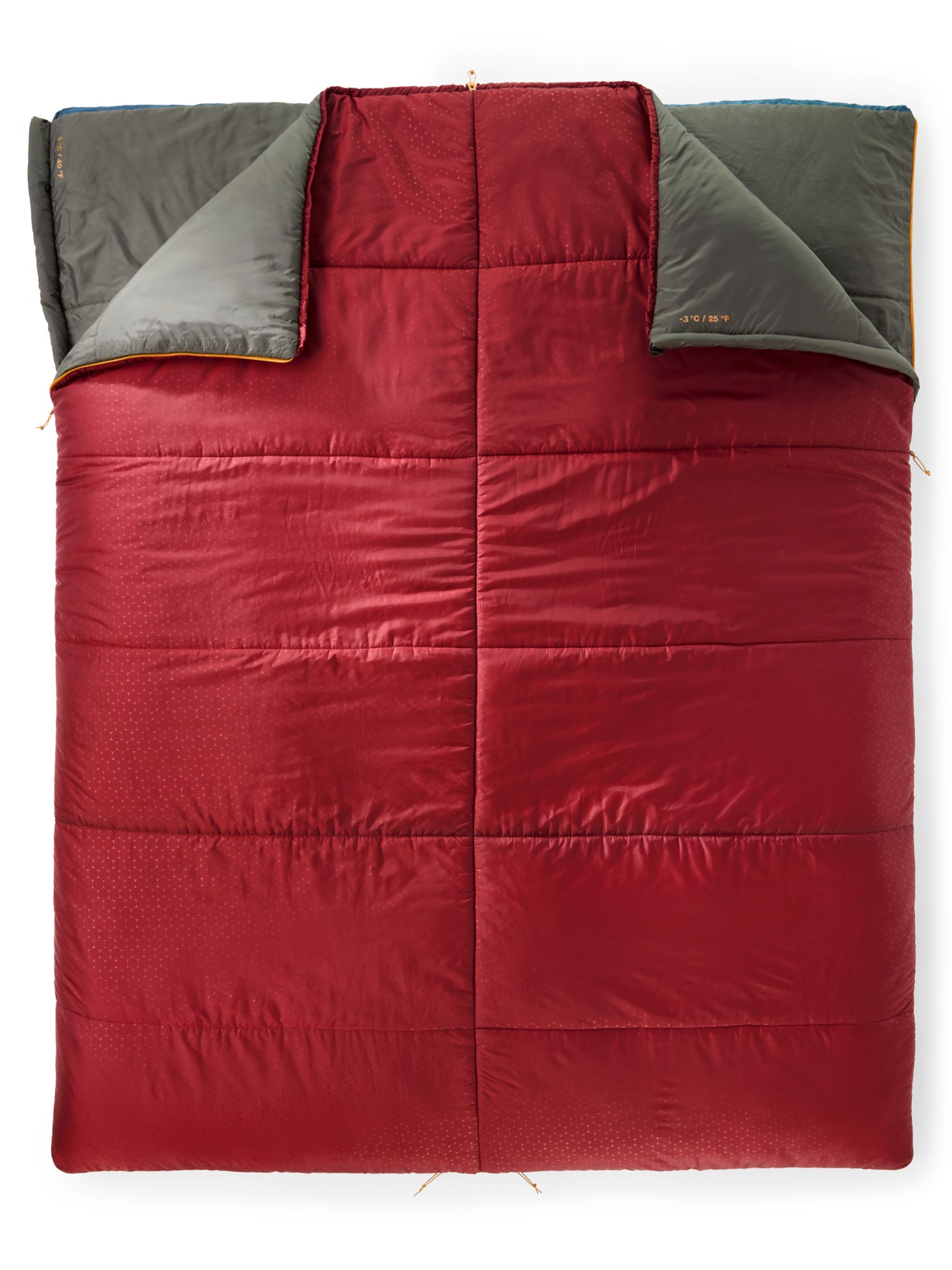 Shape: Rectangular (double)
Shape: Rectangular (double)
Temperature ratings: 25° and 40°F
Fill: Synthetic
Weight: 8 lb. 0 oz. (one size)
What we like: A well-executed double bag that can transform into two singles.
What we don’t: Not that warm due to the lack of a hood or a cinch cord.
There aren’t a ton of innovative ideas cropping up in the camping sleeping bag market, but we like Exped's creative MegaSleep Duo 25/40. This design addresses our main complaint about double bags: versatility when you need to sleep solo. Exped accomplishes this by including what amounts to two separate sleeping bags: one with a 40-degree Fahrenheit rating and the other with a 25-degree rating. You end up with six different sleeping options: a warm-weather double bag (blue side up), a colder-weather double bag (red side up), two blankets (25 or 40 degrees), and two solo sleeping bags (25 or 40 degrees).
However, as with most rectangular models, the MegaSleep Duo lacks warmth-trapping features like a tapered cut and cinchable hood for sealing out the cold. In other words, the 25-degree rating should suffice for modestly chilly nights, but we wouldn't push it. The body heat from your co-camper will certainly help, but we recommend wearing a beanie to help keep your upper half warm. The bag is also pretty hefty at 8 pounds all in, although it's lighter than the Nemo Jazz above. If you're intrigued by the versatility of this bag and want something you could also take backpacking, a bag like the Kelty Cosmic 20 above wins out with better warmth for the weight. But for more casual campers, we love that the MegaSleep allows you to sleep with a partner or on your own, and to change up configurations depending on how cold it is.
See the Exped MegaSleep Duo 25/40
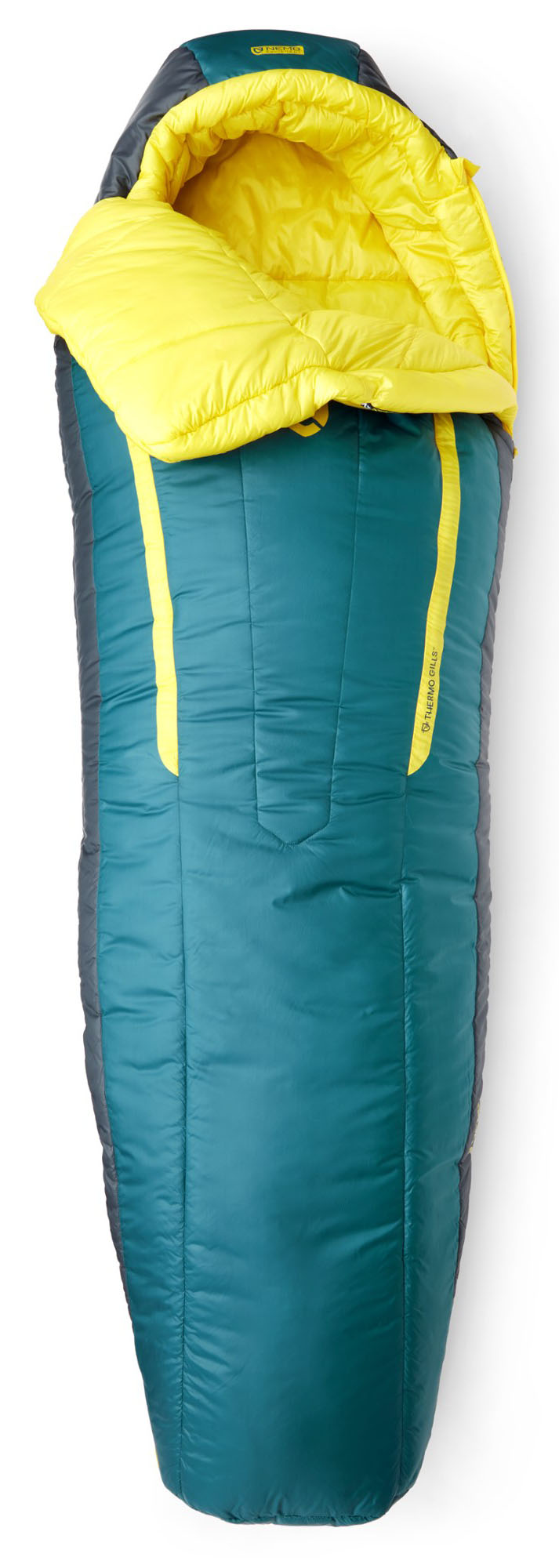 Shape: Semi-rectangular
Shape: Semi-rectangular
Temperature rating: 19°F (men's ISO limit), 8°F (women's ISO limit)
Fill: Synthetic
Weight: 3 lb. 7 oz. (men's), 3 lb. 10 oz. (women's)
What we like: A sustainable take on one of our favorite Nemo bags.
What we don’t: No longer a viable crossover option for occasional backcountry use.
We covered Nemo’s Disco above, which is a nice crossover option for those who like to get out into the backcountry on occasion. However, that bag doesn’t come cheap at $300, and car campers uninterested in roughing it can save a considerable $100 with the Forte Endless Promise 20. In this case, Nemo opted for synthetic rather than down fill, which translates to a higher weight and bulkier packed size. But most of the premium features remain, including the roomy “spoon” shape that’s a boon for side and finicky sleepers, an integrated pillow pocket, zippered “gills” to regulate temperature, a built-in blanket along the collar, and even a compression sack for stuffing it down. All told, it’s another thoughtfully made Nemo bag that’s high on comfort and quality.
It's worth noting that the Forte Endless Promise replaced the standard Forte a while back, and we have mixed feelings about the changes. On the bright side, the latest bag is one of the most sustainably built designs on the market (along with Nemo’s own Disco above) with a fully recycled shell and insulation, along with bluesign-approved materials. Like the Disco, the Forte is also recyclable at the end of its lifespan, which is a nice solution for helping reduce waste. However, at 3 pounds 7 ounces (and 3 lb. 10 oz. for the women's version, which has 1 lb. 2 oz. more fill), the Forte Endless Promise is considerably heavier than its predecessor and no longer a viable crossover option for backpacking. The price also went up by $20, making the latest model even less of a value. But for environmentally conscious campers who put a premium on comfort, there’s a whole lot to like about the Forte Endless Promise.
See the Men's Forte Endless Promise 20 See the Women's Forte Endless Promise 20
 Shape: Rectangular
Shape: Rectangular
Temperature ratings: 15°, 30°, and 50°F
Fill: Synthetic
Weight: 10 lb. 2 oz. (regular)
What we like: Three sleeping bags in one.
What we don’t: Heavy, bulky, and expensive.
For a fun take on warmth regulation, The North Face Cozy One Bag features a unique layering system that allows you to swap between three different temperature ratings. During summer months or warm nights, simply crawl inside the thinnest bag with its 50-degree limit. Then, as the temperature drops, zip on the loftier midlayer (rated to 30 degrees Fahrenheit) or add the third section on top for shoulder-season camping down to 15 degrees. All three bags are insulated with The North Face’s down-mimicking ThermoBall Eco insulation, which does a nice impression of down’s lofty warmth, and we love that the exterior is soft to the touch and avoids the slippery feel common among traditional nylon shells.
What are the drawbacks of this all-in-one system? For starters, The Cozy One Bag is pretty expensive for camping use at $300. For comparison, the top-rated Wawona Bed 20 is less than half the price, and all most casual campers will need. Further, with so many moving parts, switching between layers isn’t an entirely seamless process. And from a heft and bulk perspective, the Cozy One Bag is far from feathery or streamlined at 10 pounds 2 ounces all in. But for those who get out regularly from spring until fall and often find themselves running hot or cold, the Cozy One Bag is a well-executed and highly versatile option. For similar adaptability without breaking the bank, check out the Teton Gear Polara 3-in-1 below, which is considerably cheaper but less premium. A final option to consider is The North Face’s mummy-shaped One Bag, which uses a mix of 850-fill down and synthetic fill for added warmth and better compressibility in a lighter (3 lb. 13 oz.) package.
See The North Face Cozy One Bag
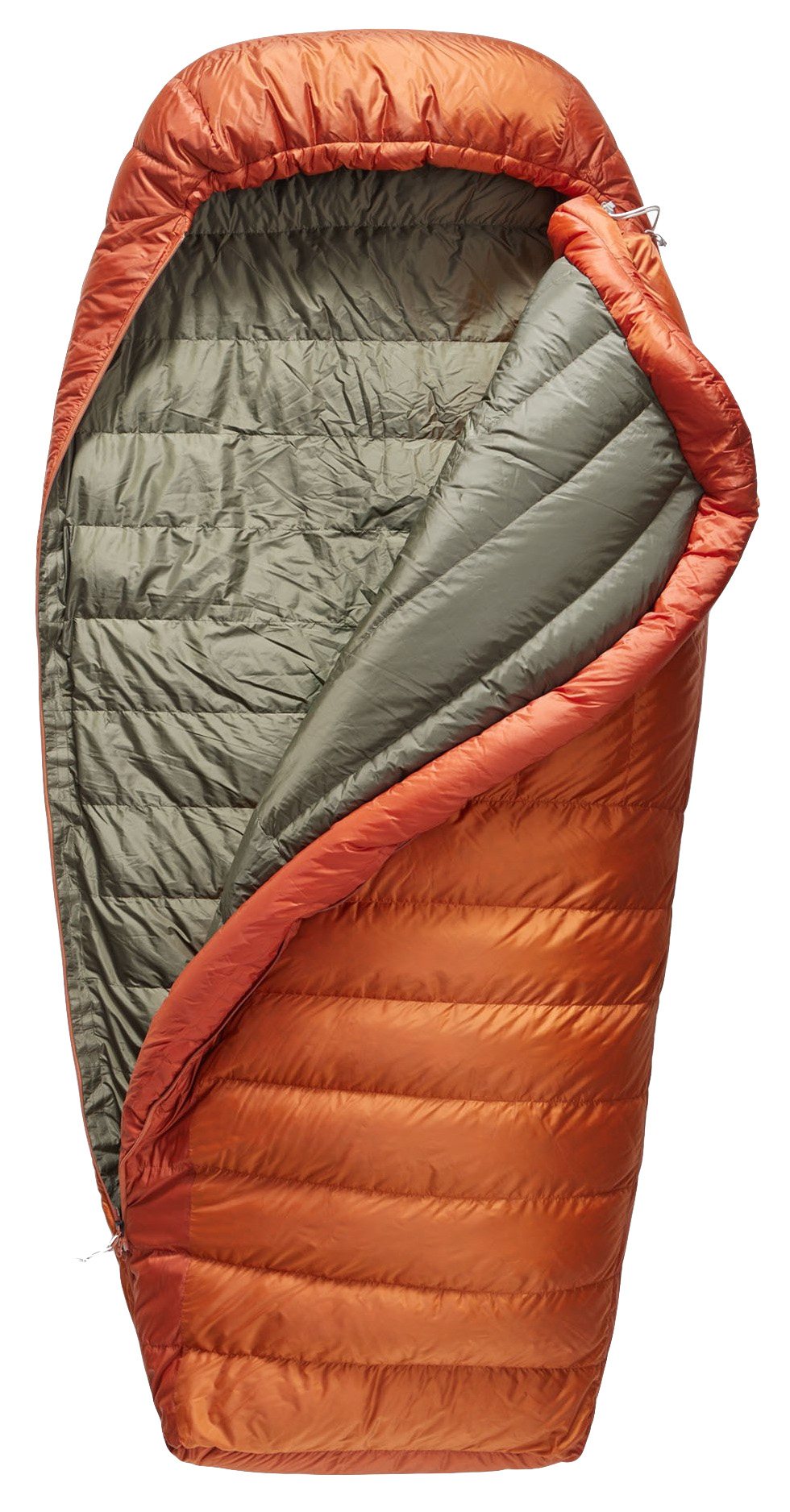 Shape: Semi-rectangular
Shape: Semi-rectangular
Temperature rating: 15°F
Fill: 650-fill down
Weight: 4 lb. 0.3 oz. (regular)
What we like: About as premium as it gets for a camping sleeping bag.
What we don’t: Very expensive and overkill for those who only get out occasionally.
For frequent campers and those willing to spend up for quality, Sea to Summit’s Basecamp 15 has a whole lot going for it. First is warmth: The bag is insulated with a healthy dose of 650-fill down and rated to 15 degrees Fahrenheit, making it viable well into the shoulder seasons when temperatures start to dip below freezing. If you wake up warm in the middle of the night, it’s easy to air things out with Sea to Summit’s Free-Flow Zip system, which allows you to unzip either side of the bag or footbox (on particularly balmy nights, you can also fully unzip the upper section for use as a quilt). Final highlights include a semi-rectangular shape that does a great job balancing comfort and weight, a generously sized hood that easily swallows a camping pillow, a hydrophobic treatment on the down for added protection against moisture, and vertical baffles around the torso to keep the insulation in place.
We can’t argue with the Basecamp’s premium build and lofty warmth, but it’s an undeniably steep investment at $399. Committed campers who get out a lot may find the high-end construction, full feature set, and well-executed venting system worth the steep price tag, but it’s decidedly overkill for those who spend only a few nights outside a year. Additionally, we’d recommend exercising caution around sharp objects like rocks and branches, as the Basecamp’s shell fabric is relatively thin and more susceptible to snags and tears than many other alternatives here. But if you take reasonable care of your gear and are willing to splurge, the Basecamp is one of the most premium options available and a real boon for comfort seekers.
See the Sea to Summit Basecamp 15
 Shape: Rectangular
Shape: Rectangular
Temperature rating: 0°F (-25°F and 25°F available)
Fill: Synthetic
Weight: 4 lb. 14.5 oz. (regular)
What we like: Mummy hood increases warmth in cold temperatures.
What we don’t: Cheap build quality.
Teton Gear is a value-oriented brand, and their camping-ready Celsius offers a lot of bang for your buck. For $90 (and often available for less on Amazon), you get a 0-degree temperature rating and a practical construction that attaches a mummy bag’s hood to a rectangular bag. And while the temperature rating is overly generous—depending on how warm or cold you run, this bag may not even be comfortable around freezing—the Celsius does an admirable job sealing out the chill with insulation around your head and a drawcord at the top. If you run particularly cold, it's also offered in a -25-degree Fahrenheit version.
As expected for this price point, the Teton Celsius falls short of more expensive bags in build quality and overall comfort. To start, the shell fabric feels cheap and the zipper can be finicky to use. Further, the polyester fill does not compress well, and it can be a real pain trying to stuff it back into the included storage bag. But it delivers decently on warmth, which is why it’s a top seller year after year. Just be aware that the Celsius runs consistently short, and we needed to go up to the XXL length to get a proper fit. For another cold-weather option from Teton, check out their Deer Hunter collection, which includes bags rated all the way down to -35 degrees (although, again, temperature ratings can be subjective, and it’s important to add in a sizable buffer).
See the Teton Gear Celsius 0
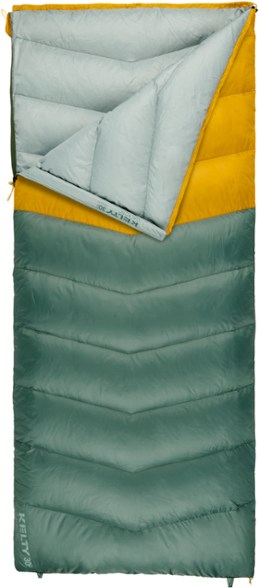 Shape: Rectangular
Shape: Rectangular
Temperature rating: 30°F
Fill: 550-fill down
Weight: 2 lb. 14.5 oz. (one size)
What we like: Cozy down insulation and a roomy rectangular shape.
What we don’t: Less versatile than the Cosmic Down above.
Colorado-based Kelty has been in the camping business for a long time, and we like what they’ve come up with in the Galactic 30. What makes this bag unique is its combination of 550-fill-power down with a rectangular shape. Most traditional camping bags stick to synthetic fill for cost savings, but lofty down clusters offer a premium feel and warmth that polyester just can’t match. And as we’ve come to expect from Kelty, the Galactic is solidly built and priced pretty affordably at $180.
What are the downsides in choosing the Galactic 30? First off, the latest Galactic no longer has a hydrophobic treatment on the down, which we appreciated on the past model for added wet-weather protection. Further, unlike the Teton Gear Celsius above, the Galactic omits a hood, which is extremely useful for maximizing warmth. Finally, the rectangular shape and 30-degree temperature rating mean that it isn’t viable for most backpacking trips, which is one of the main reasons to go with a packable and lightweight down bag. As a result, the mummy-shaped Kelty Cosmic Down above is a more versatile crossover camping/backpacking option, but we still love the recipe of cozy down warmth in a roomy and affordable package that the Galactic provides.
See the Kelty Galactic 30
 Shape: Rectangular
Shape: Rectangular
Temperature rating: 0°F
Fill: Synthetic
Weight: 7 lb. 15.9 oz. (one size, bag and liner only)
What we like: Very warm and cozy, good construction quality, comes with a well-sized compression sack with cinch straps.
What we don’t: Heavy and bulky, removable liner can get bunched up.
If you're intrigued by the versatility of a 3-in-1 design, the Polara 3-in-1 from Teton Gear is worth a look. For just $130 (and often on sale), it delivers a comfy and plush sleeping bag with an additional super cozy fleece liner, giving you three options depending on the weather and how warm or cold of a sleeper you are. We were overall impressed with the quality of this sleeping bag during testing (it feels like a step up from the Coleman Brazos in this regard), and we were especially pleased by the compression stuff sack that comes with your purchase. Not only is it actually big enough to easily pack the bag into (many are irritatingly tight), but the sack has well-functioning cinch straps to help get everything just a little more compact for travel.
On the flip side, the Polara is a great example of "jack of all trades, master of none". While the bag and liner together are very cozy and warm, the liner attaches via one zipper at the bottom and three velcro tabs in the middle. What this means is that when you inevitably roll over inside the bag, the fleece liner gets bunched up. This is a major con and left us using just the outer bag 80-90% of the time. That's all fine and well, but we feel the price is a bit steep for just the bag and the inner liner isn't very cozy to use on it's own as a blanket because of the zippers. We wish the liner was sold separately so you could choose whether you include it for an upgraded price or not. Overall, if price isn't a major factor, we would choose this over the Coleman Brazos above. But if you're shopping in that range, we think the REI Siesta is the better buy.
See the Teton Gear Polara 3-in-1
 Shape: Rectangular
Shape: Rectangular
Temperature rating: 20°F (30°F available)
Fill: Synthetic
Weight: 5 lb. 12.8 oz. (one size)
What we like: Another good value from Coleman with a focus on compressibility.
What we don’t: Surprisingly hefty given its packability; lacking in attention to detail.
Synthetic sleeping bags are a dime a dozen, but Coleman continues to stand out for their strong focus on value. The Kompact 20 here is no exception, combining the affordability that Coleman is known for with many of the features we look for in a quality 3-season bag. These include soft yet durable fabrics, an insulated draft tube to seal in warmth, and a roomy rectangular shape that’s comfortable and not restrictive. And as its name suggests, the Kompact packs down pretty well for a 20-degree synthetic bag, measuring 9.8 x 15.7 inches when compressed into its stuff sack (for comparison, REI Siesta Hooded above is larger at 11 x 16 in.).
That said, you do make some concessions by saving with the Coleman Kompact 20. Attention to detail is one area of weakness, including numerous reports of snagging zippers, an interior pocket that’s prohibitively small, and less warmth than the 20-degree temperature rating would suggest (it’s best to add in a sizable buffer). Additionally, despite the decent packability, the Kompact is one of the heaviest single-person bags on our list at nearly 6 pounds. But these downsides do little to detract from the Coleman’s value, and it’s a considerable step up in build quality compared to their 20-degree Brazos above (which is also heavier at 6 lb. 15.2 oz.).
See the Coleman Kompact 20 See the Coleman Kompact 30
| Sleeping Bag | Price | Shape | Temp | Insulation | Weight* | Packed Size |
|---|---|---|---|---|---|---|
| REI Co-op Siesta Hooded 20 | $149 | Retangular | 20°F | Synthetic | 5 lb. 7.3 oz. | 11 x 16 in |
| Nemo Jazz 30 Double | $350 | Rectangular | 30°F | Synthetic | 8 lb. 14.7 oz. | 16 x 33 in. |
| Coleman Brazos 20 | $59 | Rectangular | 20°F | Synthetic | 6 lb. 15.2 oz. | 11.5 x 19 in. |
| Nemo Disco EP 15 | $300 | Semi-rectangular | 16°F | 650-fill down | 2 lb. 11.0 oz. | 8.5 x 11.5 in. |
| Kelty Cosmic Down 20 | $180 | Mummy | 20°F | 550-fill down | 2 lb. 7.0 oz. | 8 x 13 in. |
| Alps OutdoorZ Redwood -25 | $200 | Rectangular | -25°F | Synthetic | 11 lb. 8 oz. | 12 x 39 in. |
| TNF Wawona Bed 20 | $130 | Rectangular | 20°F | Synthetic | 4 lb. 14.3 oz. | 11 x 20 in. |
| Exped MegaSleep Duo 25/40 | $250 | Rectangular | 25°, 40°F | Synthetic | 8 lb. 0 oz. | 12.5 x 27.5 in. |
| Nemo Forte EP 20 | $200 | Semi-rectangular | 19°F | Synthetic | 3 lb. 7.0 oz. | 9.5 x 18 in. |
| TNF Cozy One Bag | $300 | Rectangular | 15°, 30°, 50°F | Synthetic | 10 lb. 2.0 oz | 11 x 26 in. |
| Sea to Summit Basecamp 15 | $399 | Semi-rectangular | 15°F | 650-fill down | 4 lb. 0.3 oz. | 7.9 x 19.7 in. |
| Teton Gear Celsius 0 | $90 | Retangular | 0°F | Synthetic | 4 lb. 14.5 oz. | 11 x 16.5 in. |
| Kelty Galactic 30 | $180 | Rectangular | 30°F | 550-fill down | 2 lb. 14.5 oz. | 7.5 x 15 in. |
| Teton Gear Polara 3-in-1 | $130 | Rectangular | 0°F | Synthetic | 7 lb. 15.9 oz. | 12 x 17.5 in. |
| Coleman Kompact 20 | $100 | Rectangular | 20°F | Synthetic | 5 lb. 12.8 oz. | 9.8 x 15.7 in. |
*Editor's note: The listed weight, packed size, and temp ratings are for the men's or unisex version of each sleeping bag.
The Switchback Travel team has been testing camping sleeping bags since 2016, when we started with a list of 10 picks. While some big names have held a spot ever since (REI, Kelty, Coleman, Big Agnes, The North Face), the exact models we consider to be the best have shifted notably. Sleeping bags tailored to more casual frontcountry car camping adventures used to be primarily synthetic, but nowadays, we're seeing a lot more down-filled or hybrid offerings, as well as more diversity in shape and intended application. Our current list showcases 15 picks that span a wide price and temperature range. More and more people get outside every year, so we're continually updating this list with our favorite offerings in the hopes that there's an option here to fit your needs, no matter how and where you choose to adventure.
Former editor-in-chief John Ellings started this guide all those years ago. An avid outdoorsman with two young children, he understands the importance of a comfortable night's sleep. Current editor-in-chief Penney Garrett now curates this list, along with input from the entire Switchback team. Our crew of athletes and adventurers spends a lot of time sleeping under the stars and is intimately familiar with what works and what doesn't. From features to materials to temperature ratings, we've spent multiple nights sleeping (and sometimes shivering) in each of these bags to help you hone in on the best choice. Read on to learn more about the nitty-gritty details, and don't forget that no sleeping bag is complete without a proper mattress or sleeping pad.
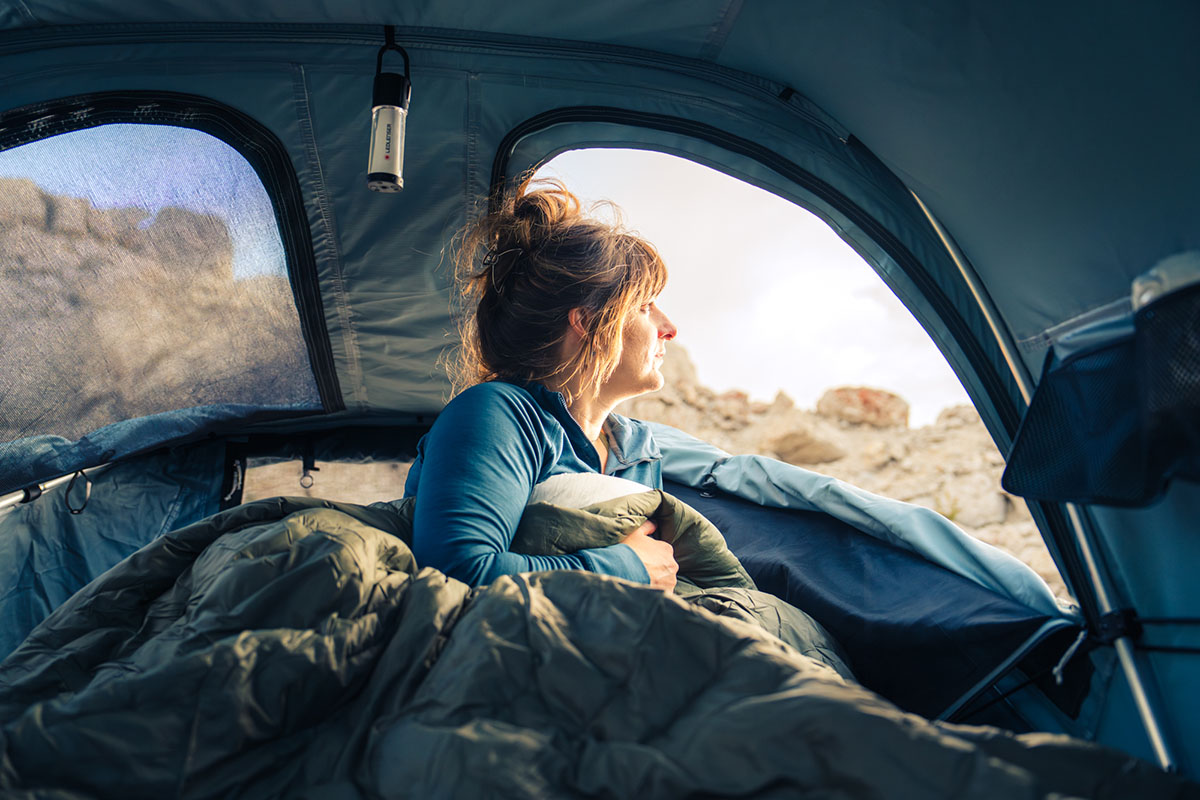
Camping sleeping bags fall into two general categories: rectangular bags that offer plenty of room to roll around in and pared-down mummy designs. Most campers stick to the more spacious rectangular shape, as these versatile bags can often be completely unzipped down one side for use as a quilt on hot nights or as a blanket for two. Most don’t include a hood, so plan your sleepwear accordingly if you run cold or are expecting cooler temperatures—e.g., a beanie or hooded jacket—though there are exceptions to this rule, like REI's Siesta Hooded 20. Also, most rectangular bags are heavy and don't pack down very small, so if you are looking for an all-in-one option for camping and backpacking, we recommend choosing a mummy-style bag.
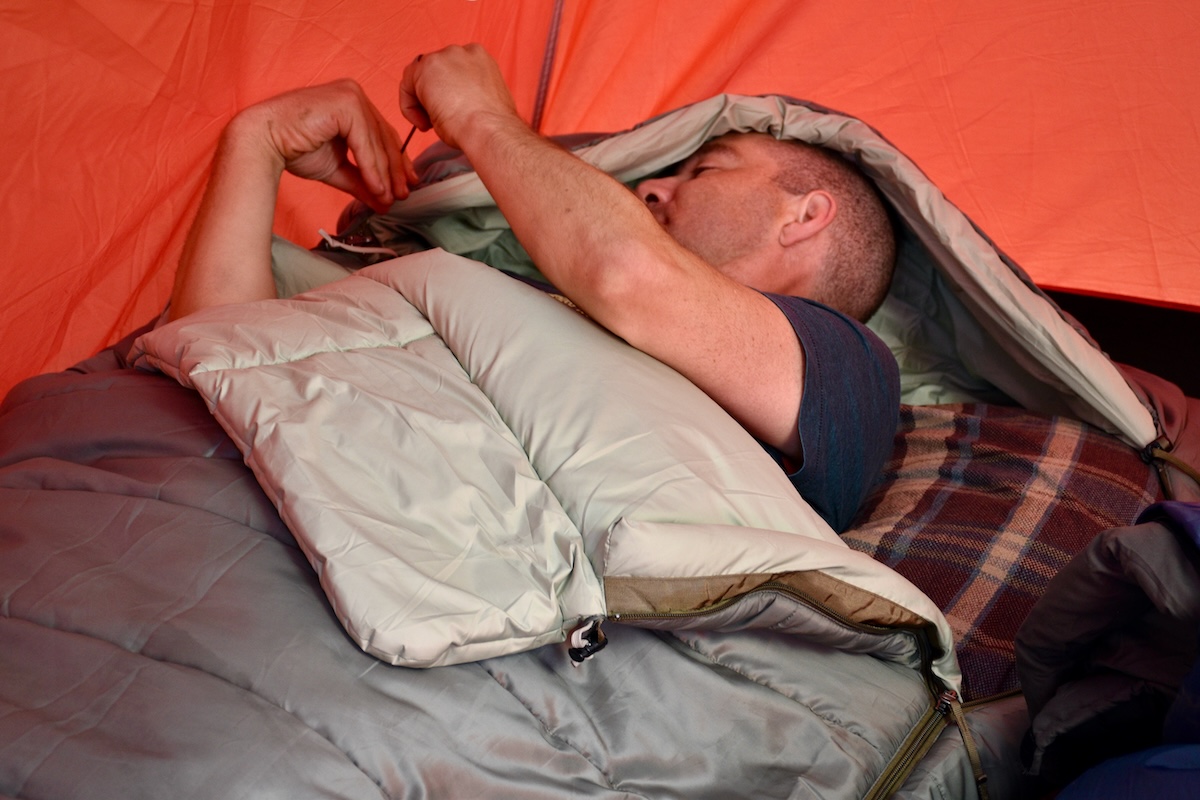
Mummy sleeping bags trim away material in the shoulders, hips, and feet for a shape that mimics your body. The advantage of having a tapered cut is that there isn't much extra space for cold spots to creep in. And with a quality hood cinched around the top of your head, you can really maximize the temperature rating potential. If you find yourself at higher elevations or in colder temperatures, a mummy bag is the way to go.
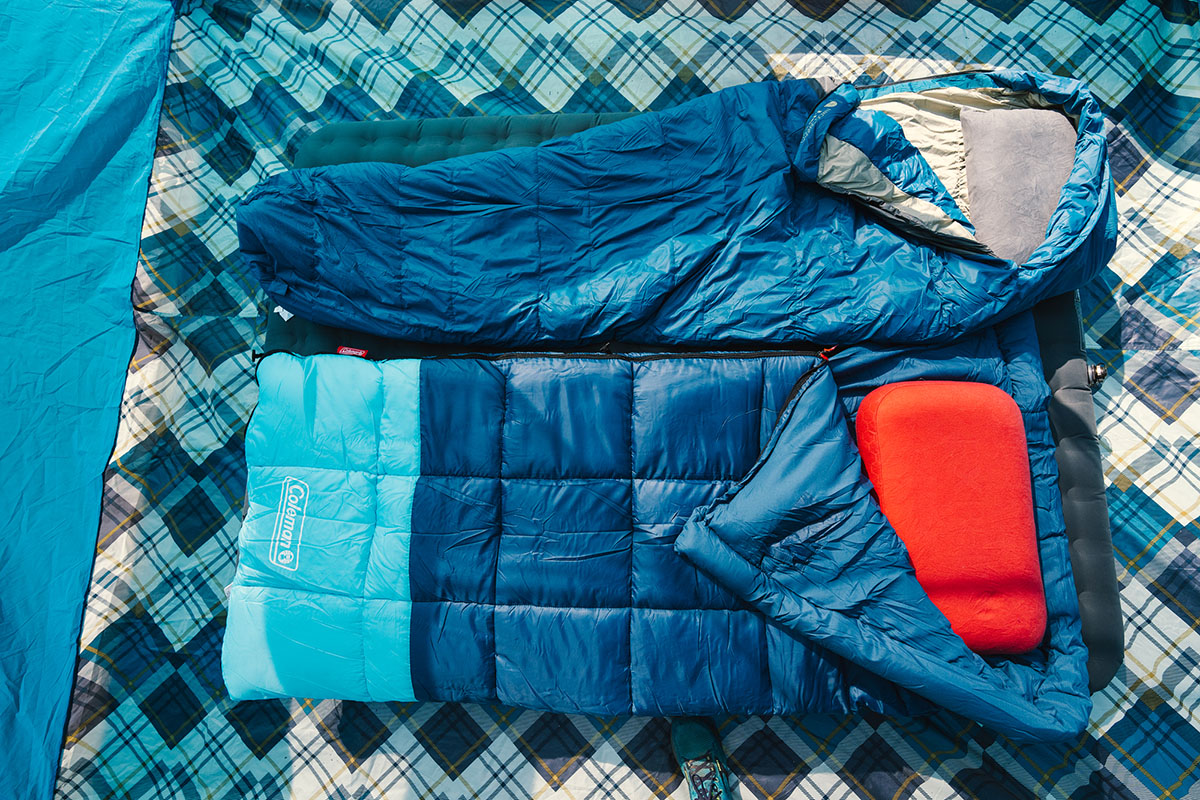
A final shape worth mentioning is the semi-rectangular bag, which—as the name implies—shares commonalities with both rectangular and mummy designs. In terms of dimensions, they’re typically roomier than standard mummy bags (particularly at the shoulders and hips) but not overly generous like some rectangular models. All in all, semi-rectangular bags typically offer a good mix of comfort and weight, shaving away excess material while still providing enough space to roll around during the night. For instance, Nemo’s Disco Endless Promise 15 and Forte Endless Promise 20 have roomier fits than most traditional mummy bags, with a noticeable boost in space around the knees and elbows.

Sleeping Bag Dimensions
Related to shape, a sleeping bag’s dimensions can have a sizable impact on all-night comfort, especially for folks with body types that depart from the standard fit mold. For reference, most standard-sized sleeping bags are 72 inches long, and shoulder and hip width vary depending on the shape: Rectangular bags are roomier in these areas, while mummy bags trim away fabric to minimize weight. To accommodate a wider range of body types, many manufacturers also offer “short” and/or “long” versions that typically share a similar width but with less or more length. For those with broader builds, Coleman offers a healthy lineup of “Big & Tall” bags that are 77 inches long and around 72 to 80 inches wide at the shoulders and hips. And Big Agnes took an innovative approach with their Wedgie Bag Expander, which allows you to add 7 inches of shoulder girth to many of their bags. The main takeaway: There are lots of shapes and sizes to choose from, and a final decision will come down to what fits your needs and feels best.
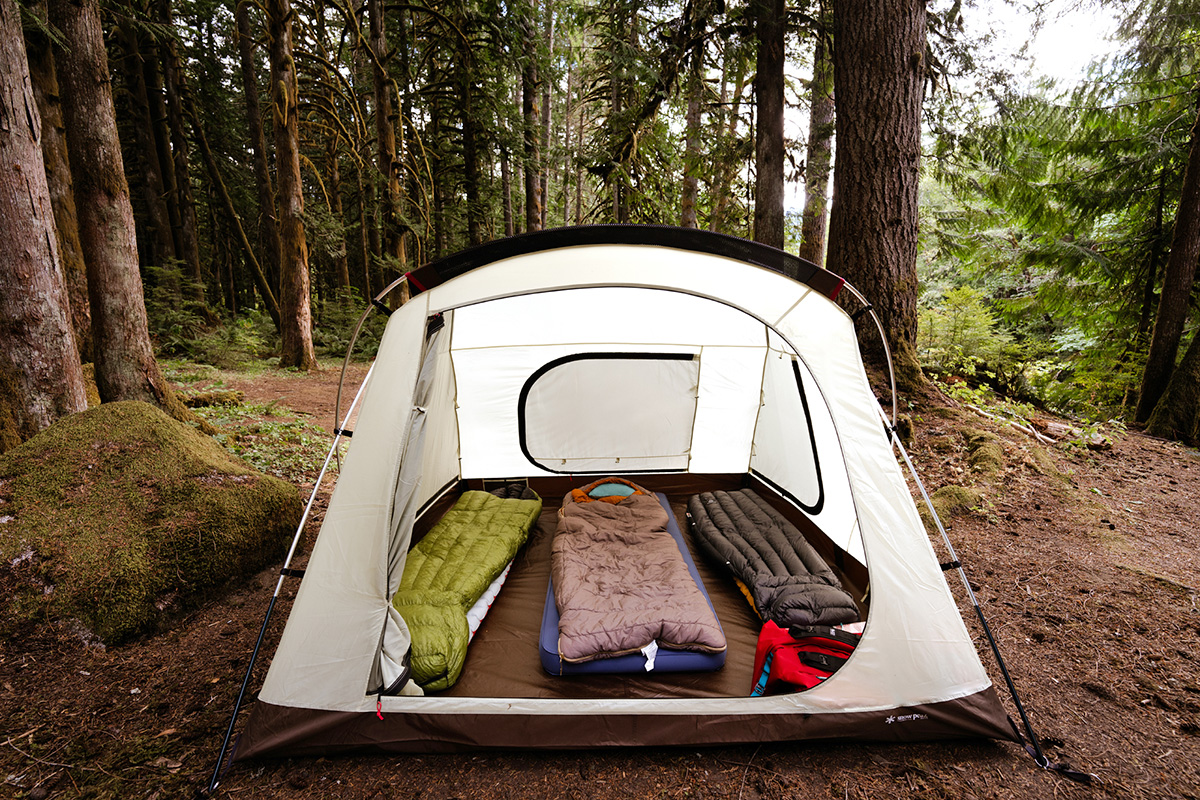
Let’s make this clear right off the bat: It’s important not to treat sleeping bag temperature ratings as hard truths. Unlike backpacking sleeping bags, which are mostly assigned a rating through a standardized process (formerly the EN rating system and, more recently, the ISO), individual manufacturers assign the ratings for the majority of camping bags. As such, there are some major discrepancies once you have them out in the real world. One reason for this is due to the shape of many camping bags—a rectangular bag that has a wide opening on one end will not retain heat in the same way a sealed-off mummy bag can.
In the end, the temperature rating does have value and you should use it as a basic guideline. In choosing the proper approximate rating, try to get an idea of the very coldest temperature you'll be experiencing overnight. Once you have that number, it’s a good idea to build in a little buffer (we like an extra 10-15 degrees) to avoid getting cold. Keep in mind that the temperature rating is closer to a survivability rating than being comfortable and warm. So if the nighttime temps will get down to 40 degrees Fahrenheit, a bag rated to 25 or 30 degrees would be our preference. Other factors to consider are your age—people typically don’t sleep as warm the older they get—and whether you are a cold or warm sleeper. Most campers stick to the warmer months for their outdoor adventuring, and as a result, most of the sleeping bags on this list are rated in the 15 to 30-degree range.

There are two types of insulation used for camping sleeping bags: manmade synthetic fibers and down insulation made up of clusters of duck or goose feathers. Down offers the ultimate warmth-to-weight ratio along with excellent packability, which is why it’s highly valued for backpacking sleeping bags. For car camping bags, however, weight and a compact stuffed size usually aren’t major considerations. In addition, down is much more expensive than synthetic insulation. For instance, even a “budget” down sleeping bag like the Kelty Cosmic Down 20, which uses lower-quality down (550-fill), costs around $30-$50 more than an equivalent synthetic option. And the gap is much larger for premium down bags, which can cost $400 or more.
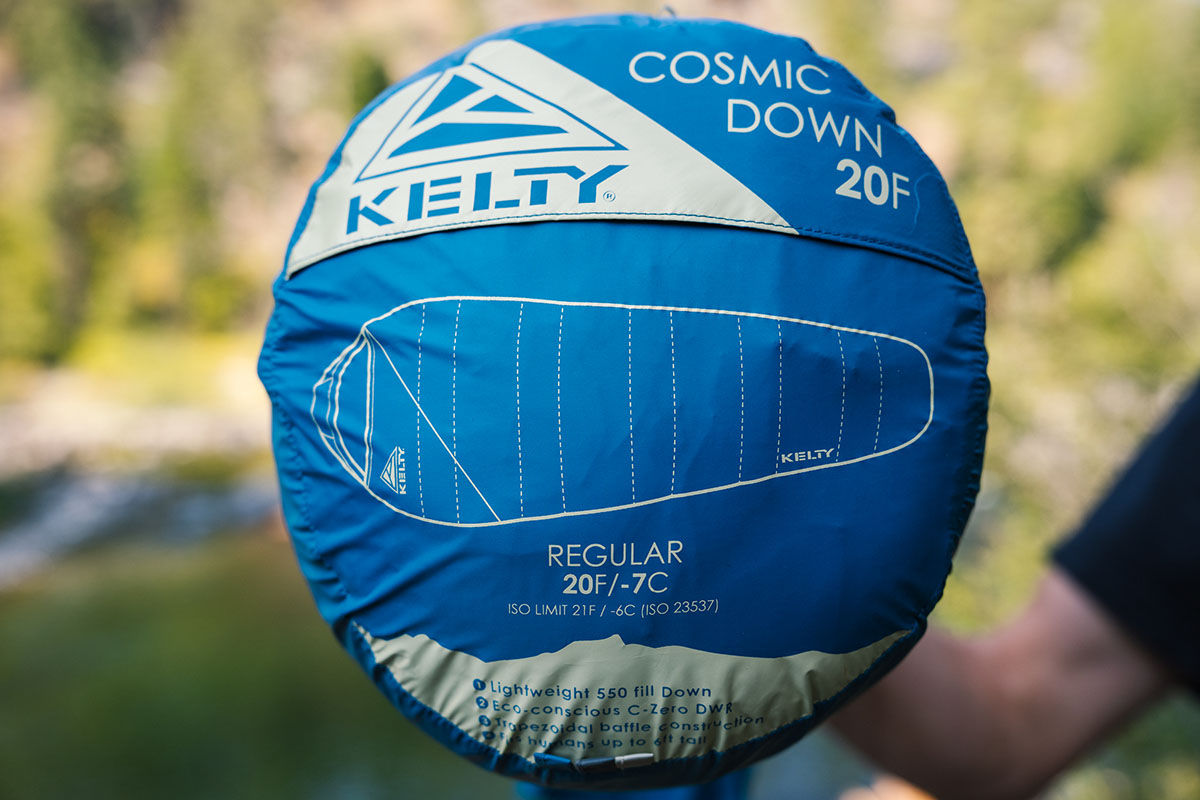
Synthetic insulation dominates the camping sleeping bag category because of its affordability and practicality—for reference, 11 of the 15 bags on our list above are packed with synthetic fill. The compromises in choosing the cheaper insulation type are relatively minimal for camping. With a car or camper to transport all of your gear, the larger stuffed size and extra weight are much less of a concern than when your sleeping bag has to be crammed into a pack and carried on your back. And should the insulation get wet, synthetics continue to keep you warm, unlike down feathers. For a full explanation of the two insulation types, see our article on down vs. synthetic.

Camping has a sweet simplicity to it, and one of the great things about driving (or walking a short distance) to your campsite, is that you don’t need anything too special from your camping sleeping bag. Realistically, you can get a great sleeping bag for under $150. Spending extra brings features like softer liner and shell fabrics and a lighter overall weight, which is worth it for some, but most campers will be happy with a tough nylon shell, a healthy dose of synthetic fill, and a cozy flannel interior. The Teton Gear Celsius and Alps OutdoorZ Redwood are great examples: they are plenty warm (the Redwood is so warm that you'll likely want to avoid it in the summer months), comfortable, and tough enough to keep using year after year. At the other end of the spectrum are ultra-premium designs like the Sea to Summit Basecamp 15 ($399), which uses down insulation and comes with a host of upgraded features (but again, many campers will be perfectly happy saving toward the cheaper end).

For most, the primary weight and packability consideration for a camping bag is whether or not it can be carried from the garage to the car, squeezed in with the rest of your stuff, and then moved from the trunk to the tent. That said, we still recommend checking the weight and packed size listed in the product specifications to get an idea of just how large and heavy your bag will be. Synthetic bags are typically made with thicker fabrics and require more insulation to provide sufficient warmth, which can add up to a surprising amount of bulk. And if you’re considering a double bag (covered in more detail below), you’re talking about packed dimensions listed in feet rather than inches. If weight and packed size become important, a crossover backpacking/sleeping bag like the still-roomy Nemo Disco Endless Promise 15 reduces both.
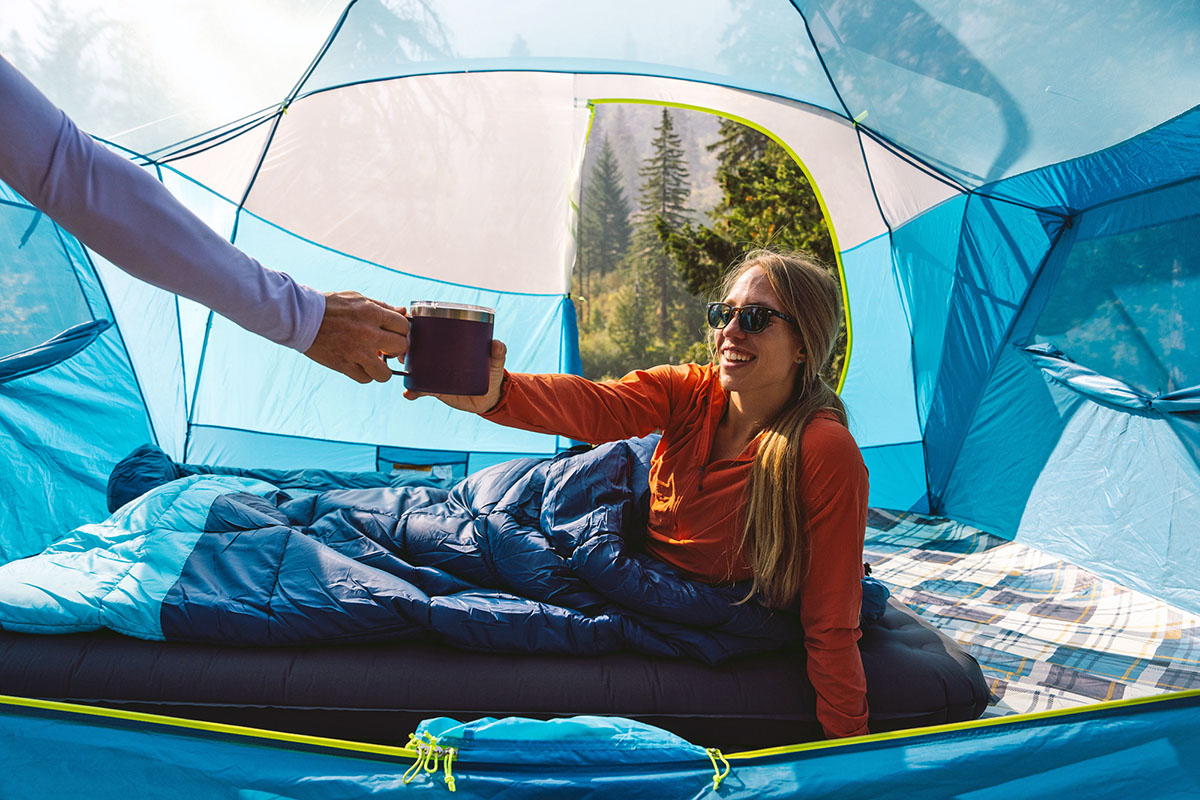
The interior of a sleeping bag varies quite a bit between designs, but one general rule of thumb is that comfort correlates closely with price. Comparing two of our picks, Coleman’s cheap Brazos 20 uses a tricot lining that’s reasonably cozy but less soft than The North Face Wawona Bed (especially the smooth fleece-like panel along the top of the Wawona’s interior). Some campers won’t mind missing out on the plush feel for the substantial cost savings (about $60 separates The North Face and Coleman options), but a well-made bag is undoubtedly a nice place to slip into at the end of the day. For those who plan to get out a lot, opting for an upgraded design may be worth it.

Mummy bags typically have a ¾-length side zip that requires some wriggling to get in and out of and can’t be opened up completely should you want to zip the sleeping bag together with another compatible bag or use it as a quilt. That’s why we prefer a bag that fully unzips for more casual camping. Not only is it easy to create a large and comfortable space for two if you can zip one bag to another, but unzipping the bag on its own opens it up for use as a blanket. And if the bag has a tough exterior shell, you can also use it as an outdoor picnic blanket in a pinch.
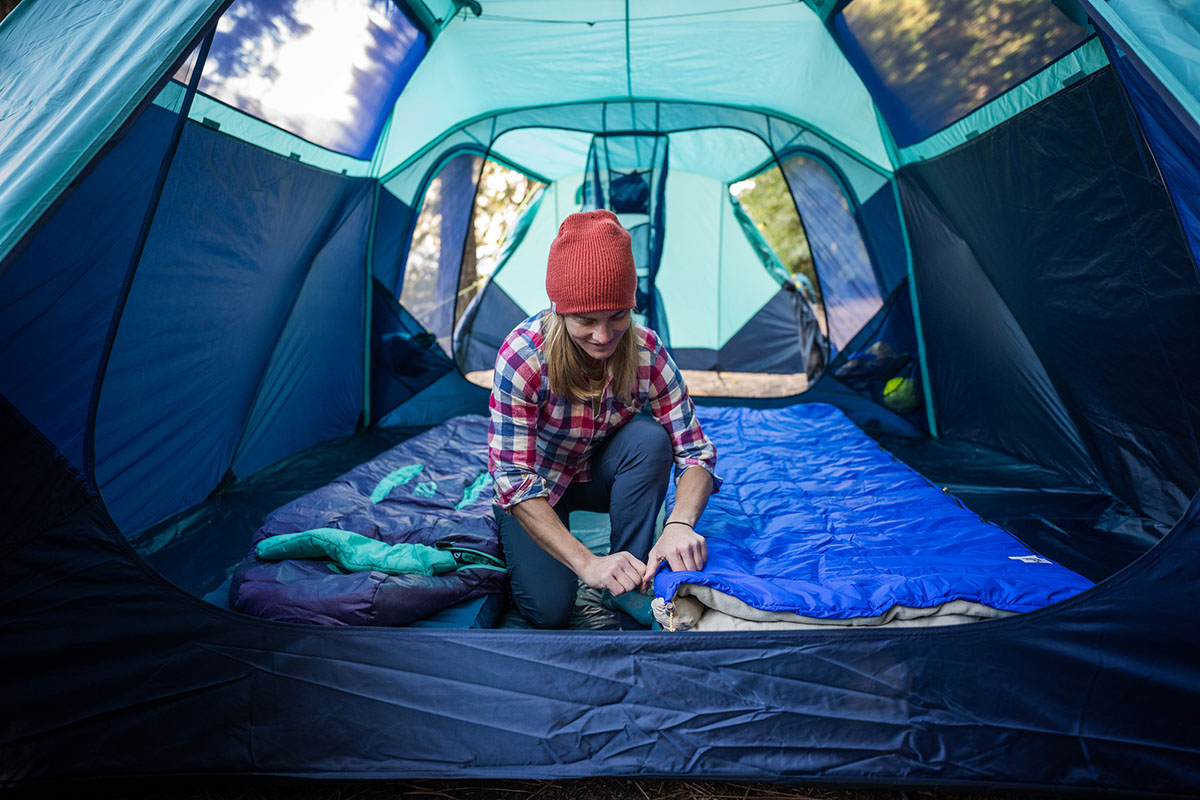
A third type is the no-zip style, which is a more limited offering (none of the options on our current list are this type), including a handful from Sierra Designs. The large oval opening requires some modest flexibility and patience to get out of, but going zipper-less can be nice. There's no fumbling in the night for the zipper pull, and you don’t have to worry about snags or heat loss. But in the end, we don’t see the zipper-less concept completely taking over the market. Put simply, the in-and-out convenience and ability to use your bag as a blanket thanks to a zipper is the better answer for most campers.
Sleeping bags are inherently barebones, but we’ve seen an uptick in available features on many mid-range and high-end models of late. Notable extras worth calling out are built-in pillows or pillow sleeves (the Nemo Disco and Forte Endless Promise both boast the latter), which are a nice luxury for those annoyed by camp pillows that tend to move in the night. Additionally, integrated blankets, interior pockets for stowing small items like a headlamp, and draft tubes at the collar for trapping warmth are becoming more common.

Some bags, like The North Face Cozy One Bag, feature unique warmth-tailoring systems that allow you to customize the amount of insulation depending on conditions. And venting options are nice if you tend to run warm, including full-length zippers that allow you to use your bag as a quilt, “gills” along the top of the bag that can be opened up to release some heat (Nemo's Disco and Forte include these), and footbox zippers for sticking just your toes out. To be sure, most of these additions aren't absolutely necessary, but they can be helpful in deciding between similar models (and we’ve called them out in the write-ups above whenever possible).
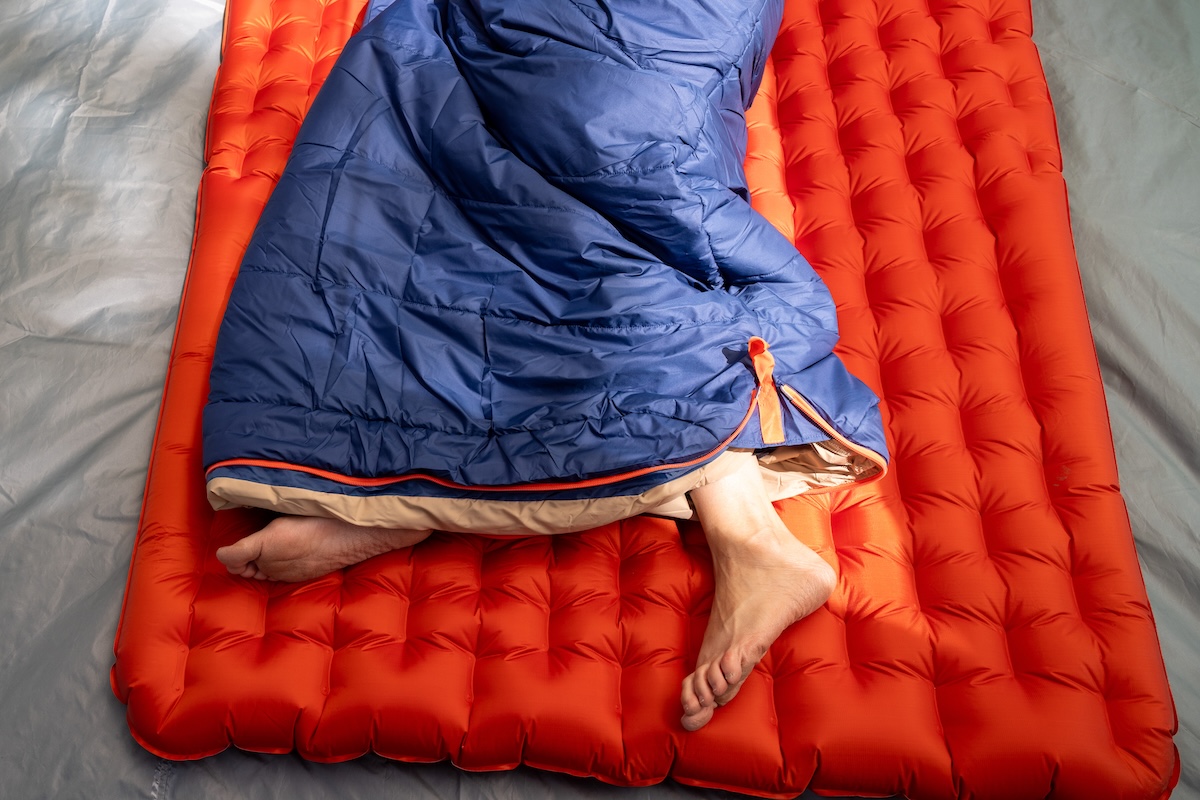
Many leading outdoor brands have upped their sustainability focus in recent years by incorporating recycled fabrics and other eco-friendly measures into production. REI is a clear leader in this realm: In addition to being Climate Neutral Certified, many of their bags—including the Siesta above—use recycled and bluesign-approved materials that have been sourced and produced to minimize their overall impact on the environment. As far as down options go, Sea to Summit's Basecamp 15 uses plumage certified to the Responsible Down Standard (RDS), which indicates the birds were treated humanely (e.g., no force-feeding or live-plucking). And Nemo’s Endless Promise bags, including both the Disco and Forte above, can be recycled at the end of their lifespan to reduce waste. Finally, PFAS-free DWR coatings are becoming more common as many states are stepping up to ban the sale of items that include per- or polyfluorinated chemicals—"forever chemicals" known to be harmful to the environment.
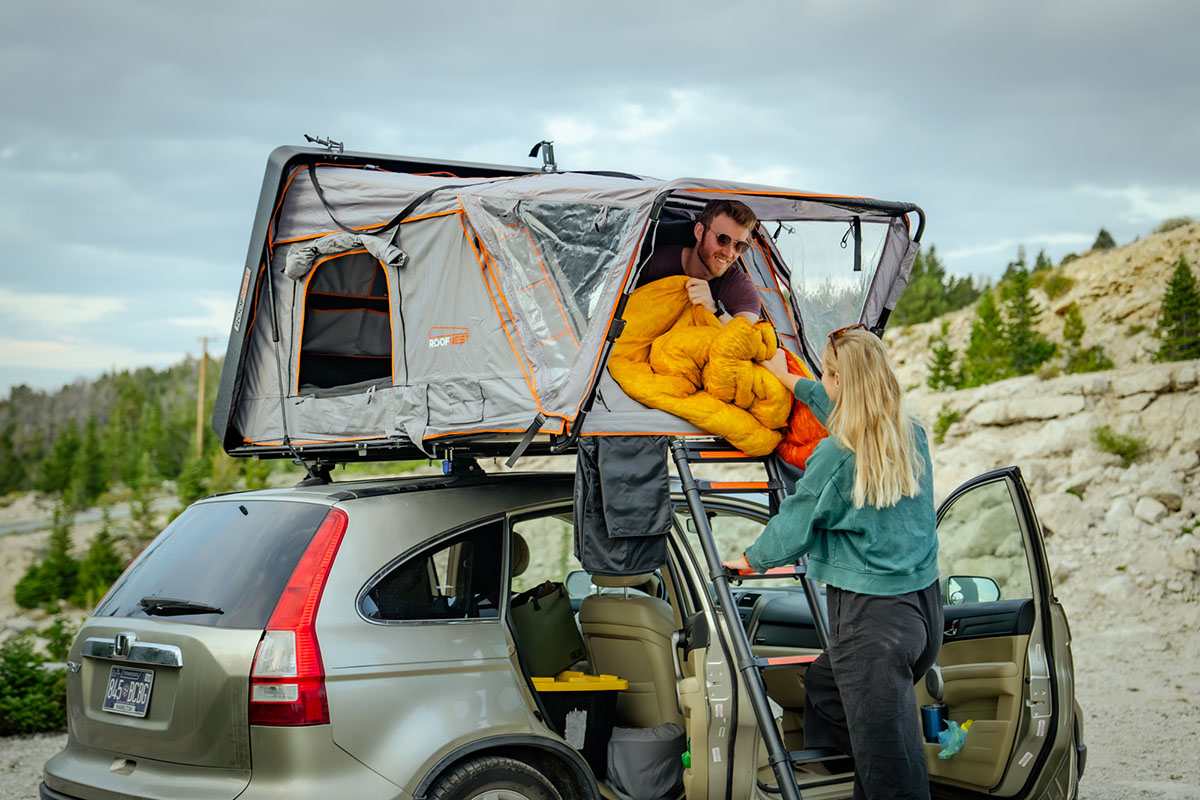
It’s not cheap outfitting an entire camping setup, and for those who plan to add backpacking into the mix, the cost can get out of hand quickly. If this sounds like you, choosing a crossover camping/backpacking bag is a viable way to save. A few models above can pull double duty for both activities with few compromises, including the Nemo Disco Endless Promise 15 and Kelty Cosmic Down 20. Both bags weigh less than 3 pounds, compress reasonably small for stuffing into a pack, and offer enough warmth for most 3-season adventures.
That said, the all-in-one answer comes with some compromises. Crossover designs typically are less roomy than true camping bags to shave weight and bulk (the Nemo's “spoon” shape bucks this trend by increasing the width in important areas like around the elbows and knees), and they often use thinner fabrics that require added care and are more prone to tears. Finally, dedicated backpackers can go much lighter with more targeted models that use ultra-premium down and even more compromised shell materials, but cost goes up considerably (for a full list of options, see our article on the best backpacking sleeping bags).
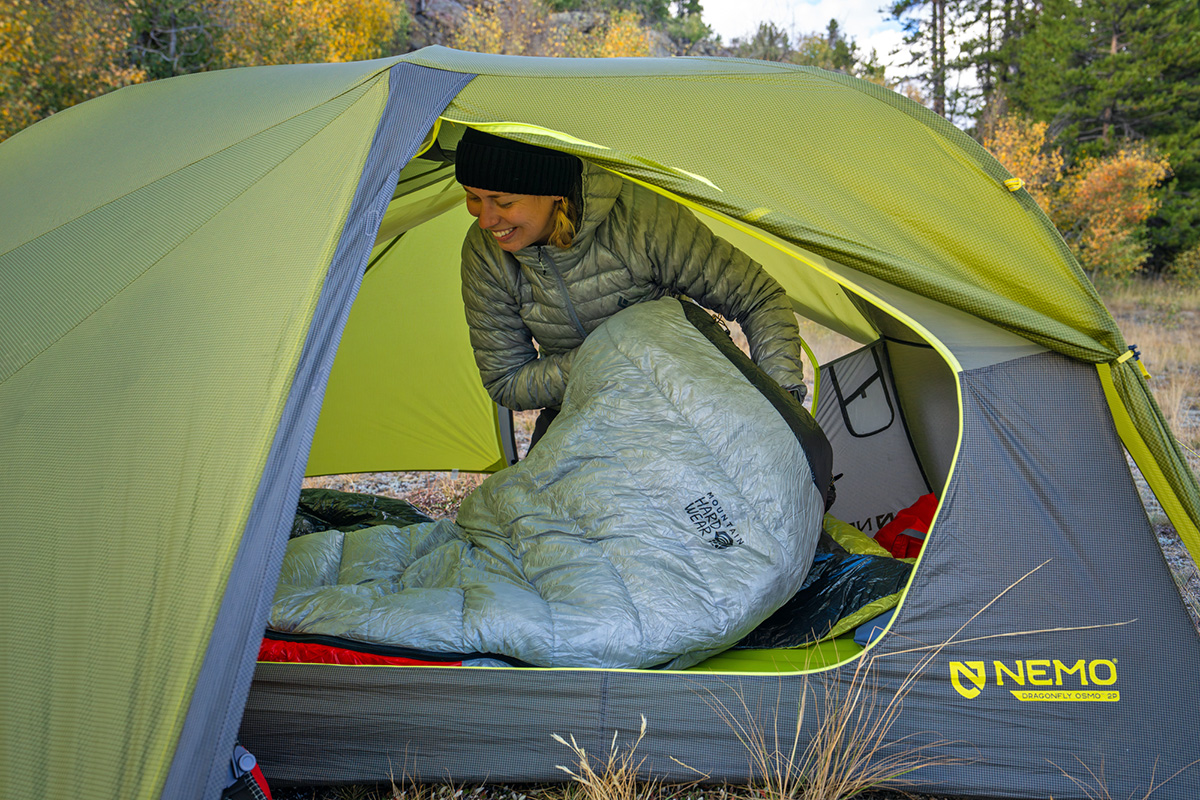
A double sleeping bag is simply a standard sleeping bag with a doubled width to accommodate two campers sleeping side-by-side. These bags are often an effective selling point to get a reluctant partner to finally try out camping. But is it worth getting the double bag as opposed to just zipping two compatible sleeping bags together? In all honesty, typically not. While they’re undoubtedly spacious and a touch cheaper than getting two single bags, we’ve never been in a scenario where zipping two bags hasn't worked just as well—and it gives you the flexibility to camp solo as well (Exped's MegaSleep Duo is one of the few to address this issue). But who are we to tell you not to get a traditional double bag? And if you find it’s what you want, we recommend the aforementioned Exped MegaSleep or Nemo's luxurious Jazz 30 Double. Not only is the Exped a double, but it has enough room inside for an adult on each side and a storm-frightened toddler (or dog) in the middle.
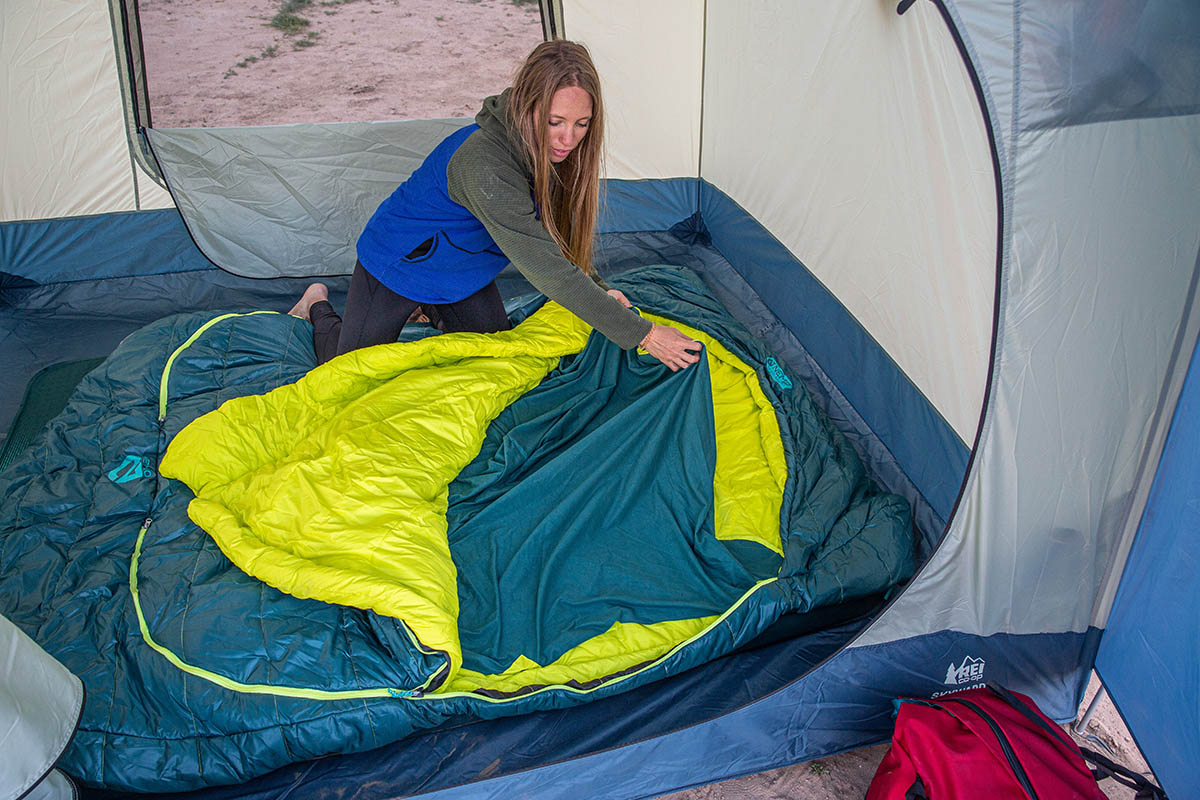
If you have a little kiddo or are shopping for one, we highly recommend picking up a sleeping bag that is sized proportionally. Unless you only camp in areas with very warm overnight temperatures, a 4.5-foot person in a sleeping bag designed for a 6-footer is a recipe for cold and uncomfortable nights—they just can’t heat all of that extra space. A bag like the Big Agnes Little Red 20 with an integrated sleeping pad can help you save money as you outfit your mini camper. And a final note: Kids’ bags are often made in a bunch of fun colors, which sure doesn’t hurt in getting them excited for some time spent outdoors.
As we touched on above, temperature ratings tend to be fairly generous and often require adding a sizable buffer to ensure you’ll stay warm throughout the night. For those who run cold or simply want to bring their bag into lower temperatures, adding a sleeping bag liner can help keep you cozy without breaking the bank. Liners are made of soft materials like fleece, wool, polyester, or silk and typically add around 5 to 15 degrees to the warmth rating of your bag. They also serve as a barrier between you and your bag’s interior, which can help boost lifespan (you can wash the liner after use rather than getting your bag dirty). Liners typically cost between $40 and $70, and a couple of our favorite options are Sea to Summit’s Thermolite Reactor for mummy bags and their Comfort Sleeping Bag Liner for rectangular models. To be clear, liners are totally optional and not everyone needs one, but they do offer added warmth and comfort and help keep your bag in good shape.
If you’ve ever had a pad deflate or slept directly on the ground in cold weather, you know firsthand the importance of an insulated pad beneath you. Further, when you lay on a sleeping bag, you compress the insulation, which impacts its ability to warm you (this is particularly true for down fill, but does impact synthetic as well). As a result, it’s important to choose a sleeping mattress or pad that will protect you from the ground if you’ll be camping in cooler temperatures (typically under 50-60 degrees).
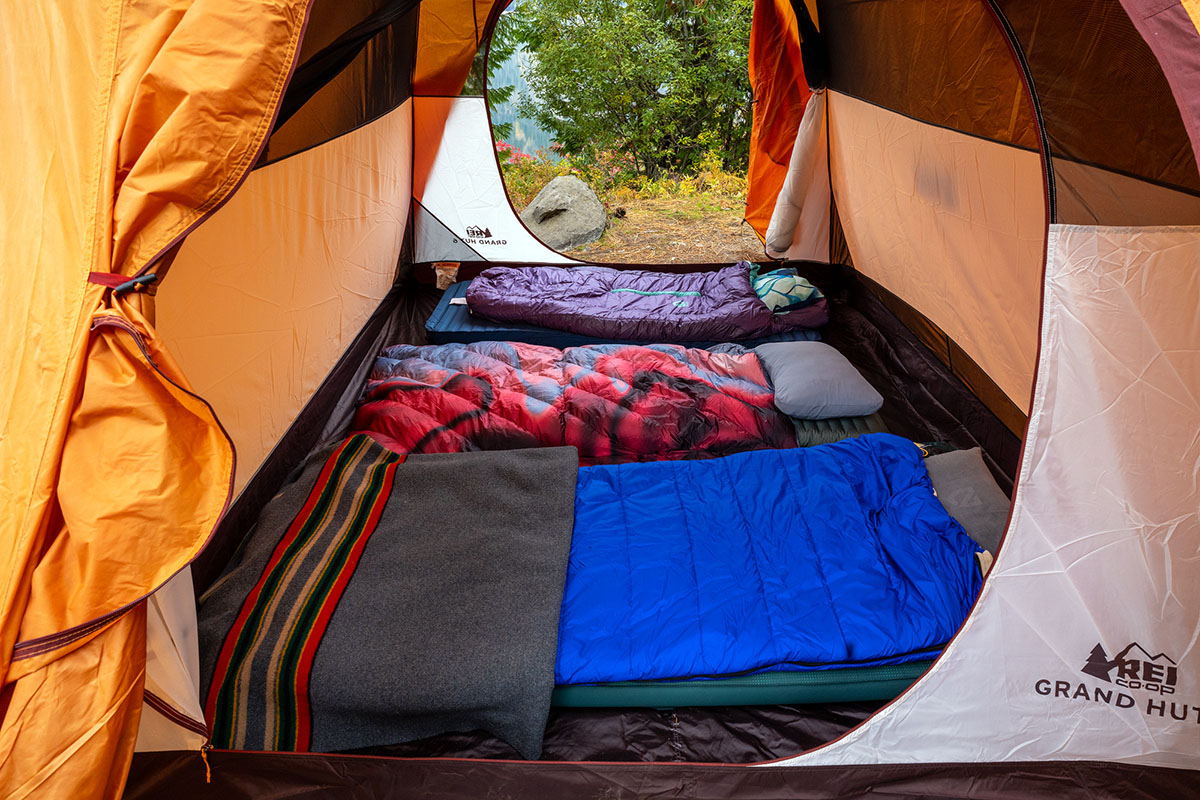
For summer camping where it stays warm at night, you can use a large, uninsulated airbed, but if it’s cold, get a sleeping pad with some form of insulation (most often synthetic or foam). Sleeping pads are given an R-value rating, and the higher the number, the better it insulates you from the cold. As a general guideline for 3-season use, we recommend a rating between 3 and 5. Summer campers can get away with less, while winter adventurers will want something that exceeds 5 (and may want to consider adding a second pad for additional protection). Check out our favorite camping sleeping mattresses for a breakdown of our top picks as well as buying advice.
Back to Our Top Camping Sleeping Bag Picks Back to Our Sleeping Bag Comparison Table